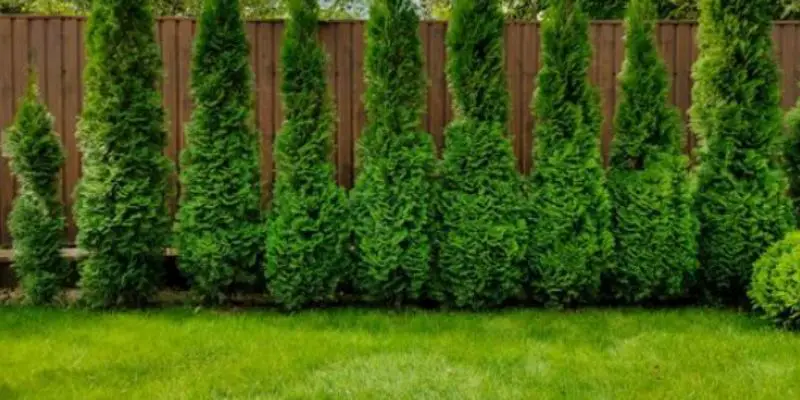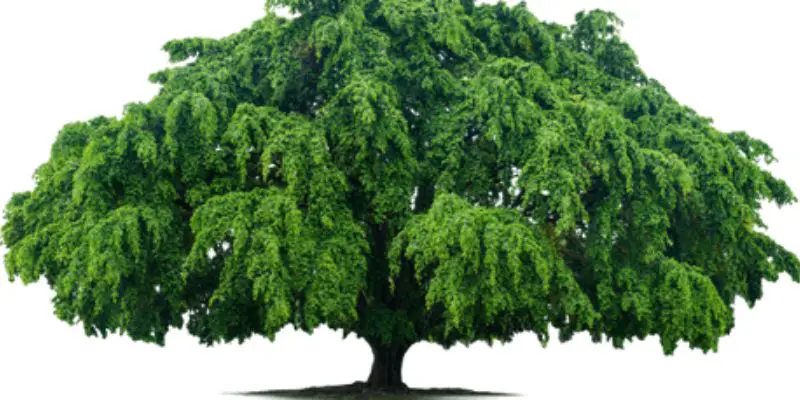You’ve put so much hard work into crafting an absolutely beautiful yard and landscape. Those towering green giant arborvitae trees play a huge role, providing wonderful privacy while adding incredible texture and form. But over time, those green giants can start to look a bit overgrown if you’re not careful. No need to panic though. With the right approach, you can keep them looking crisp, neat, and magazine-cover worthy for years to come.
By the end of this detailed guide, you’ll be an expert on how to trim green giant arborvitae trees like a pro. You’ll learn all the best tools to use, the ideal techniques to follow, and the perfect timing for pruning. Your green giants will maintain that gorgeous, natural pyramidal shape instead of turning into wild, shaggy monsters.
What is a Green Giant Arborvitae?
The green giant arborvitae (scientific name: Thuja Standishii x plicata ‘Green Giant’) is a fast-growing, extremely hardy evergreen tree variety. It’s a clever hybrid created by crossing the giant arborvitae and the western arborvitae species.
Green giants are top-notch when it comes to withstanding brutal winter conditions, able to shake off temperatures as low as -40°F without blinking an eye! These robust trees grow at a breakneck pace of 3-5 feet per year when young. At maturity, green giants typically reach towering heights of 30-50 feet tall and impressive widths of 10-12 feet if allowed to grow unchecked.
Their most iconic feature is that distinctly dense, pyramidal form draped with flat sprays of the lushest, greenest evergreen foliage you’ve ever seen. The fresh, woodsy scent from their foliage is an added delightful bonus. It’s no wonder these striking specimens are a hugely popular choice for homeowners!
Green giants absolutely excel at creating remarkably effective (and beautiful) privacy screens or windbreaks thanks to that rapid growth rate and unique conical silhouette. However, they do require some regular, prudent trimming and pruning to maintain that perfect form and prevent encroaching on things like sidewalks, driveways, or structures.
Why Pruning Is So Important
You might be thinking, “Hey, these trees just naturally grow in that nice pyramidal shape on their own already. Maybe I can just leave them alone and skip all the trimming hassle?”
While those green giants certainly have an enviably tidy natural form, regularly pruning them actually provides some pretty crucial benefits:
- Size and shape control – Left completely untrimmed, green giants will just keep growing outward and upward until they outgrow their intended space and start causing problems like blocking windows or paths. Pruning reins them in.
- Prevents browning/die-off – Those dense, innermost branches can turn an unsightly brown and die if you don’t periodically thin them to allow sunlight and air flow.
- Discourages pests/disease – Thinning out those interior branches removes areas where moisture can pool and unwanted insects or diseases can take up residence.
- Maintains aesthetics – Let’s be honest, a regularly trimmed and groomed green giant just flat-out looks so much better visually than one left overgrown and untamed. Neat, tidy, and intentional versus sloppy and unkempt.
When’s the Perfect Time for Trimming?
As with most pruning and trimming, timing is everything if you want to keep those green giant arborvitae looking their absolute best. Thankfully, there’s an ideal window of opportunity each year that’ll give you the best results:
You’ll want to plan to trim your green giants in late spring through mid-summer. More specifically, prune them after their new growth has emerged in spring and had a chance to harden off, but before the scorching heat of summer hits your area. Aim to have your pruning fully completed at least 6-8 weeks before the first expected fall frost in your region.
Pruning in that late spring to early summer window allows any new growth that emerges to harden off fully before winter. Cutting much later runs the risk of stimulating a late flush of tender new growth that won’t harden properly before cold temps arrive.
And as a general rule of thumb, avoid pruning or trimming evergreen trees like green giants in the fall or winter whenever possible to prevent cold-related damage.
If you simply can’t get around to pruning your green giants during that prime spring/early summer window one year, it’s better to hold off entirely until next spring rather than risk a late-season pruning job.
Grab Your Pruning Gear
Don’t even think about attempting to prune those green giant arborvitae trees without having the proper pruning gear lined up first! Using the wrong tools (or dull, low-quality ones) will only turn this task into an exercise in frustration and leave you with sloppy, uneven results.
Here’s what you’ll want to have on-hand at minimum for this job:
- Quality pruning shears or lopping shears
- Pole pruner or pruning saw
- Safety glasses
- Sturdy pruning gloves
- Ground tarp or drop cloth (optional)
For pruning those smaller branches toward the inner areas, you’ll just need a reliable pair of hand pruners or pruning shears. As you move out toward the denser outer branches, you’ll want to upsize to bypass loppers or a pruning saw for any thicker limbs.
And for efficiently reaching up into all those tall areas without needing a ladder, you can’t beat a sturdy pole pruner. These extend your reach dramatically so you can thin areas from the bottom all the way up.
Safety first! Be sure to have protection like safety glasses and gloves to shield you from any errant debris, scratches, or sap. Got bigger trees? That optional ground tarp makes easy work of cleaning up by collecting all those fallen arborvitae sprays that would otherwise litter your yard.
Before You Start Trimming: Prep Work
Before you start haphazardly chopping away at your green giants, it’s best to spend a few minutes doing some simple preparation first. This goes a long way in helping you trim with precision and achieve that ideal sculpted shape.
Make it a point to give your green giants a nice deep watering a few days prior to pruning them. This ensures the branches are well-hydrated and pliable instead of brittle, which reduces damage during pruning.
Next, take a few moments to remove any fallen debris, weeds, branches, etc from the area around the base of each tree so you have a clear workspace. Then slowly walk around each green giant, inspecting it from all angles to identify areas that need:
- Thinning of overly dense interior areas
- Shaping and triming of wayward growth
- Removal of any unsightly sucker growth from the base
Having this short planning process upfront allows you to prune strategically based on each tree’s specific needs instead of just chopping somewhat randomly. It’s a crucial step for achieving that perfect size and form!
How to Trim Green Giant Arborvitae: Step-by-Step
Ok, it’s finally time for the main event – digging right in and beginning to prune! For shaping your green giants into absolute masterpiece pyramids, follow this step-by-step approach:
- Start pruning from the bottom and work your way upward methodically, completing one section at a time.
- Focus on thinning out any overcrowded interior areas using your hand pruners. This allows ample sunlight and airflow to penetrate while decreasing pest/disease risk. Don’t be too aggressive here – simply remove a few of the innermost branches to open it up.
- Moving outward toward the outer canopy branches, use your loppers or pole pruner to cut back any errant branches or leaders that are straying from the desired pyramidal outline. Trim them back into a neat conical silhouette.
- Also trim off any side branches hanging significantly past that ideal conic pyramid shape and fouling up the clean lines.
As you work your way up, step back frequently to check your progress from multiple angles. This allows you to identify any spots where one side is looking too full or unevenly shaped compared to the others.
When pruning, always make your cuts at a slight upward, inward-facing bevel angle, rather than straight across. This prevents water accumulation on those pruning cuts. Also, avoid over-pruning into old wood – stick to trimming only new growth from the current season.
Other Quick Tips:
- Remove any completely dead, damaged, or rubbing branches
- Suckers sprouting from the base can usually be snapped off by hand
- Leave the central upward-pointing leader alone to prevent misshapen growth
- Use a pruning saw for any branches over 1 inch thick
How Much to Trim Off
Each Year You may be wondering just how aggressively to prune those green giants each season without overdoing it and harming the trees. As a general rule of thumb, most experts advise never removing more than one-third of a green giant arborvitae’s total foliage in a single year’s pruning.
Going beyond that one-third mark runs the risk of shocking the tree’s vascular system and weakening its vigor. Heavy overpruning also often leads to a sparse, unsightly aftermath until new growth emerges to fill in gaps.
For most green giants, pruning experts recommend removing just the outermost 6 to 12 inches of growth each season. This preserves the core green giants’ form while controlling the overall size.
If your green giants have become majorly overgrown after years of neglect, it’s better to break up the renovation pruning over 2-3 seasons instead of trying to hack them back into shape in one overly aggressive pruning session.
Be patient and methodical in your pruning approach, and your green giants will maintain that crisp, balanced pyramid outline you want!
Take Care to Avoid Fatigue
Even for seasoned pruning warriors, spend too long continuously trimming and shaping green giants (or any upright trees) in one session and your form and precision are bound to falter. Don’t be afraid of breaking up bigger pruning jobs across multiple shorter periods.
All it takes is one careless over-prune due to mental fatigue or a lapse in judgement to disfigure a green giant’s beautiful form. Heading back inside after an hour or two of trimming allows you to return refreshed later with a newly focused eye.
Just be diligent in not pushing yourself too hard for too long. Taking your time is the key to maintaining your green giant arborvitae in picture-perfect condition!
How to Keep Them Pampered Year-Round
Nicely done! After your detailed pruning efforts, your green giants are standing tall with neat, crisp outlines framing your property in all their splendor. But the work isn’t done just yet if you want to preserve that perfect look all year long. A few simple maintenance steps throughout the rest of the seasons will keep them healthy and gorgeous.
Spring:
- Apply an early spring fertilizer, either a balanced granular fertilizer or nutrient compost around the base
- Pull away any dead branches or debris that may have accumulated
- Assess for any pest or disease issues and treat appropriately if found
Summer:
- Water deeply during any extended dry spells, especially within 6-8 weeks after pruning
- Lightly rake away any fallen foliage to allow air circulation around the base
- Consider preventative disease treatments if it was a particularly wet season
Fall:
- Mulch over the critical root zone out to the drip line to insulate roots and retain moisture
- Give a final watering before winter if conditions have been dry
Winter:
- Gently brush any heavy snow loads off branches to avoid disfiguring
- Monitor for animal damage like rabbit/vole feeding on lower branches covered in snow
- Prune out any dead, damaged or diseased branches when temps rise above freezing
With this simple annual routine, your green giant arborvitae specimens will maintain their outstanding health and vibrant, tailored beauty year after year. Those crisp pyramids standing sentry around your landscape will truly be the envy of the neighborhood!
How to Trim Green Giant Arborvitae for Renovations
While regular light pruning each year keeps green giants looking elegant and refined, some older trees may eventually require more drastic renovation to improve their appearance and vigor. You’ll know it’s time for that major pruning “haircut” if yours have turned overly dense, sparse, browning, or misshapen after years of growing unchecked.
Don’t worry – even severely neglected green giants can often be recovered and restored to their former glory through proper renovation pruning techniques. The key is taking your time over multiple seasons instead of trying to re-shape them in one overly aggressive pruning.
To renovate older, overgrown green giants, start by removing one-third to one-half of the overall height and width in year one. Use thinning cuts to open them up and allow light penetration into the interior. Avoid pruning into old wood – stick with trimming only recent new growth. Next season, prune to refine the shape, and the following year trim any last lingering imperfections.
While this renovation process may leave your trees looking a bit bare initially, the sacrifice pays off as dense new growth flushes to restore that fresh, conical form! Have patience and prune gradually – within 2-3 seasons, an overgrown green giant can bounce back nicely.
Dealing with Deer Browse Damage
Green giants in areas with heavy deer pressure face an extra challenge. Those hungry ungulates frequently help themselves to arborvitae leaves and tender new growth, leaving those once-sculpted trees looking downright ratty and ugly after being browsed into oblivion over winter months.
While netting or fencing is the most reliable way to protect green giants from deer damage, that’s not always practical in every situation. If browsing becomes severe enough, here’s how to prune to restore shape:
- Wait to prune until after new growth has hardened off in late spring
- Carefully prune only the damaged branch tips where the deer browsed
- Thin out and reshape the rest as normal to restore pyramidal form
With some judicious pruning and time for new foliage to regrow, even severely damaged green giants can make a remarkable comeback from deer browse. Just be sure to re-evaluate deer control strategies going forward!
Renovation Stumped? Call an Arborist
Despite your best, most dedicated pruning efforts and armed with this full trimming knowledge, sometimes green giants may become too overgrown or severely misshapen for the typical homeowner to fully restore on their own. Or perhaps major storm damage leaves yours in shambles requiring more advanced pruning cuts.
In cases like these, it’s often wise to call in an experienced professional arborist to assess the situation before you inadvertently do more harm during renovation attempts. An ISA certified arborist specializes in maintaining mature trees and can make the appropriate corrective pruning cuts to restructure severely overgrown green giants back into tip-top condition.
While their services come with a price tag, a pro arborist can often save you far more in extending the lifespan of older green giants versus needing to remove and replace them entirely down the road. So don’t be afraid to ask for expert help when needed!
Final Thoughts on How to Trim Green Giant Arborvitae
With this comprehensive guide under your belt, you now possess all the tools and knowledge needed to keep your treasured green giant arborvitae trees looking trim, tidy, and spectacular for decades to come.
Remember to prune them each year in that key late spring to mid-summer window using the proper pruning and cleanup gear. Always hold back, never removing more than one-third of the total foliage in a single pruning.
Follow that proven pruning technique starting from the bottom up, thinning interiors while precisely shaping those outer branches into crisp pyramids. With some consistent annual care, your green giants will sport refined silhouettes that make jaws drop all over the neighborhood!
Even mature trees allowed to overgrow for years can often be skillfully renovated back to picture-perfect condition with a strategic multi-year pruning approach. Or reach out to a knowledgeable arborist for assistance with renovation pruning on severely neglected specimens.
By investing the effort into pruning and maintaining those green giant arborvitae with these tips, you’re ensuring they remain towering, distinctive living sculptures augmenting your property’s value and curb appeal for many years ahead. Those crisp cone shapes conveying a tailored, refined aesthetic will truly be the key focal point highlighting how to trim green giant arborvitae into absolute masterpieces!
Also read:
Best Cordless Battery Hedge Trimmers – Top 7 Reviews and Buying Guide

Michael Glenn is a certified arborist and horticultural expert with over 15 years of experience in the landscape industry. His passion for plants and trees has led him to become a sought-after authority on pruning and trimming techniques. Glenn’s in-depth knowledge of proper pruning methods, timing, and tools has helped countless homeowners and professionals maintain healthy, aesthetically pleasing gardens and landscapes.
In addition to sharing his pruning expertise through practical tips, step-by-step guides, and expert advice, Glenn is also a respected author of pruning tool buying guides. His comprehensive reviews and comparisons ensure readers can make informed decisions when investing in quality loppers, pruning shears, saws, and other essential equipment. With a deep understanding of plant biology and sustainable practices, Glenn’s writing empowers audiences with the knowledge needed to properly care for green spaces.





Hello! Someone in my Myspace group shared this site with us so I came to look it over.
I’m definitely loving the information. I’m bookmarking and will be tweeting this to my followers!
Fantastic blog and terrific design.
Great! Share widely and come back for more.